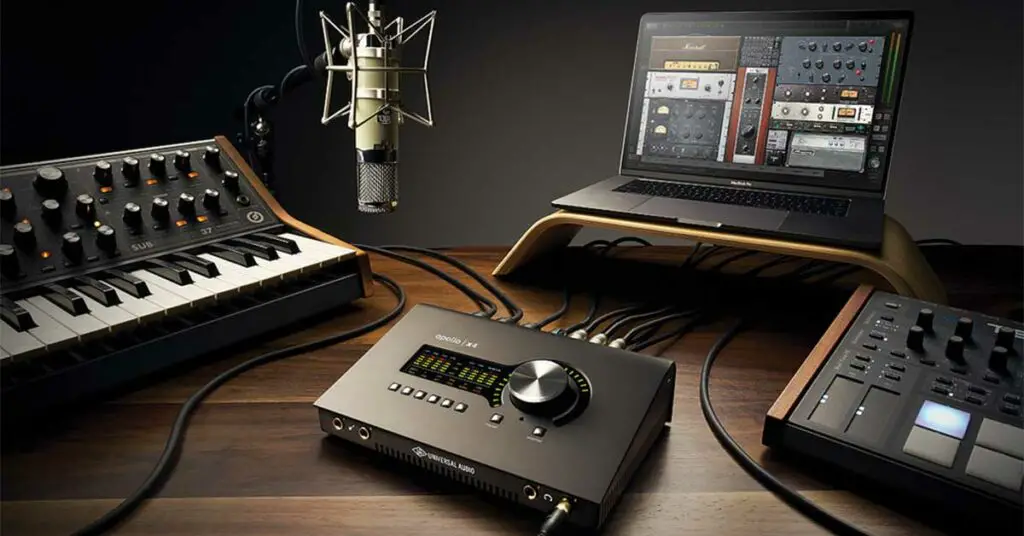Universal Audio is probably one of the most well known names in the recording industry. It was founded in 1958 by Bill Putnam, and after sixty years it still remains to be at the forefront of innovative audio technology.
Universal Audio was a favorite engineer of Frank Sinatra, Nat King Cole, Ray Charles and many more well known names.
Putnam was an innovator who is widely regarded as the father of modern recording, and a lot of his innovations are now industry standards today.
Putnam was the inventor of the modern recording console, the multi-band audio equalizer, and the vocal booth. Putnam was also the first engineer to use artificial reverberation in commercial recording.
Along with his friend Les Paul, Putnam was involved in the early development of stereophonic recording.
Putnam started three audio product companies during his career: Universal Audio, Studio Electronics, and UREI.
All three companies built equipment that remain very widely used in the industry, even after decades since their first introduction.
Some of these include the LA-2A and 1176 compressors, as well as the 610 tube recording console. The 610 console in particular was beloved and used to record the Beach Boys, among other popular artists of the era.
Later in 1999, Universal Audio was refounded by Putnam’s sons, James and Bill Jr. Their goals were to faithfully reproduce classic analog recording equipment in the tradition of their father, and to design new digital recording tools with the sound of vintage analog technology.
If you are thinking of adding a Universal Audio interface to your setup, there’s a chance you are stuck wondering what the best purchase for you is.
In this article, we’ll be talking about the differences between the Apollo Twin X and the MkII
Table of Contents
The Apollo Twin X
- A special edition of UA’s acclaimed Apollo Twin X interface — with a premium suite of 5 award-winning plug-in titles from Teletronix, Pultec, and UA — a $1,300 value
- Elite-class A/D and D/A conversion derived from Apollo X rackmount interfaces paired with 2 Unison mic preamps deliver stunning models of classic tube and transformer-based mic preamps and guitar amps
- 2 Unison mic preamps offer stunning models of classic tube and transformer-based mic preamps and guitar amps
- UAD QUAD Core Processing for tracking through vintage compressors, EQs, tape machines, mic preamps, and guitar amp plug-ins with near-zero latency
The Apollo twin is Universal Audio’s most famous desktop audio interface. It allows musicians and audio engineers to easily track, overdub, and mix music and audio.
It features a Hi-Z input, two Unison-enabled mic preamps, four line outputs, built-in talkback, high-pass filter, as well as some other features.
If the Twin X is what you are going for, don’t forget to make sure your computer has Thunderbolt 3 ports. The thunderbolt port has been upgraded to 3.0, which makes it well compatible with all the different latest versions of mac.
It also means that you will probably have an easier time as audio engineering continues to develop, as well as being very versatile with whatever music you are making.
It will also, most likely, increase speed for you; thunderbolt 3.0 is known for its speed and you will be able to enjoy the best possible experience out of the Twin X.
The Apollo Twin X also includes the LUNA recording system. It is a fully integrated music production application. The app allows autosave, AAF imports, unlimited track counting, and lots more.
The unison-enabled microphone preamps are handy when you want to record, in real-time, through any of UAD’s preamp emulations.
The sounds of different preamps available in those emulations are printed onto the recording as though you are using the real thing.
You could do the same with compression, equalization, and any number of effects- you have the option to either monitor or record those effects using UA’s Console software in tandem with your digital audio workstation.
The Apollo Twin X is the latest version, so in terms of power it is unmatched on all different models you may see from Apollo.
With its dual or quad- core processor setup, and with all the processing power you can simultaneously run multiple plugins on your computer without really having to worry.
As for whether you choose the dual or quad processor, it depends on the power you are looking for.
Remember that if you do go with the dual core, if you find yourself needing more DSP down the line, you can always purchase a UAD Satellite.
A few other things to consider when thinking about purchasing the Twin X is sound, of course. While the Twin X is not incredibly different from the MkII, many say that the Apollo Twin X preamps provide more clarity.
The enhanced AD/DA converters are also something to consider. They can provide higher dynamic range than the MkII.
Another thing to note is that every Twin comes with the Realtime Analogue Classics plugin bundle.
The bundle includes most of the UAD things you would want to use working in audio recording, including things like the 1176, LA-2A, Piltec, Fairchild, 610-B, along with a few others.
It’s convenient, but it also means that buying the Apollo interface is committing to the investment in UAD; you will probably use these plugins for most if not all your recordings and mixes.
The MkII
- A special edition of UA’s acclaimed Apollo Twin MkII interface — with a premium suite of 5 award-winning plug-in titles from Teletronix, Pultec, and UA — a $1,300 value
- Next-generation Apollo A/D and D/A conversion and 2 Unison mic preamps that offer stunning models of classic tube and transformer-based mic preamps and guitar amps
- 2 Unison mic preamps offer stunning models of classic tube and transformer-based mic preamps and guitar amps
- UAD DUO Core Processing for tracking through vintage compressors, EQs, tape machines, mic preamps, and guitar amp plug-ins with near-zero latency
The Mkll looks almost identical to the Apollo Twin X. They both have the sleek, space gray look, and as far as components go they’re very similar in that regard as well.
The key difference is that the MkII has a Thunderbolt 2 connection instead of a Thunderbolt 3. If you have an older Apple computer, you will probably want the MkII because of how it caters to older models.
Alternatively if you have an older Mac, you can use a USB to Type-C converter; this will slow the speed down, but only by a little.
The other key difference from the Apollo Twin X is that the MkII is in its preamps and AD/DA converters. The MkII will sound more vintage, while the Twin X sounds more modern.
The MkII also offers both dual-core/quad-core, but it’s still recommended, especially for beginners, that you go for the dual-core unit.
As mentioned above, it provides plenty of DSP and if you end up needing more you can buy a separate UAD satellite.
An additional thing to note is that the MkII requires additional power, so it isn’t particularly portable. Both the X and the MkII have a built-in talkback feature.
It is useful if you are a sound engineer and it can also come in handy when creating podcasts and videos- though it is not a great replacement for an actual microphone.
The Twin series also features the ALT monitoring function which allows you to alternate between two sets of monitor speakers.
Other Things to Consider
Something important to note is that Universal Audio almost exclusively works with Thunderbolt technology. If you are unfamiliar with Thunderbolt, it is an I/O technology that supports high-resolution displays and high performance data devices through a single, compact port.
Thunderbolt is a hardware interface that allows for the connection of external hardware to a computer. It uses a mini DisplayPort connector (MDP), which is also why Apple products also work with Universal Audio’s interfaces besides Thunderbolt.
If you are running Windows, the best option would most likely be the Apollo Twin USB. The USB is a 10 x 6 USB 3 audio interface that offers the Apollo conversion.
The UAD-2 DUO Core processing will let you record your music in near time with little latency.
This is through UAD plug-ins of different kinds, from Neve, Marshall, Lexicon, etc. The USB also comes with the Realtime Analog Classics bundle.
Final Thoughts
Overall, the Apollo Twin X and the Apollo Twin MkII are virtually identical. Both serve the purpose of giving an older sound to newer recordings, and they both serve that purpose incredibly well.
They both provide a lot of power and versatility with audio recording, mixing and general post-production. Which one you decide to buy only really depends on the kinds of connections your computer has.
If you’ve purchased a new Macbook within the last four years, you would probably want to go with the Twin X with Thunderbolt 3.
If you are running an older machine that only has Thunderbolt 2, there may be better options available for you.
If you do have a newer Mac with Thunderbolt 3 ports, you could potentially save a bit of money by buying an older Apollo Twin MkII and a Thunderbolt 2 to USB C adapter.
As mentioned before, the transfer speed would go down a bit, but depending on your preferences it can be negligible.
Overall, the Twin series by Universal Audio is a favorite choice of many popular artists. This includes rapper Kendrick Lamar, Post Malone, and the band Arcade Fire, just to name a few.
If you are thinking about buying something from Universal Audio, whatever you choose to buy you can rest assured that you are investing in good quality interfaces.
Investing in your digital audio workspace will pay off down the line, so it’s important to do your research when looking for the best essential equipment for you and for the sound that you are going for.
Both of these options are great, and choosing between the both can be a difficult process. Hopefully we were able to help you figure out which option works the best for you and your audio setup!





![HERE’S What Happened to the Soul Singer Al Green [2023 Update]](https://performerlife.com/wp-content/uploads/2023/04/what-happened-to-al-green-211x150.jpg)
